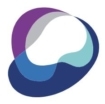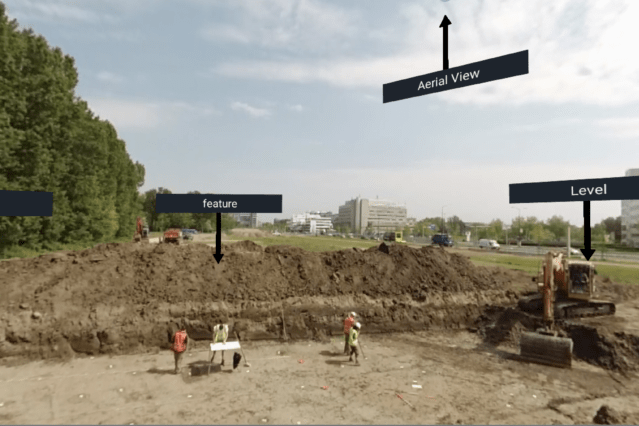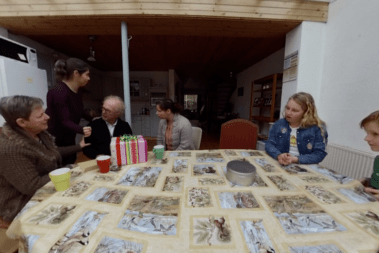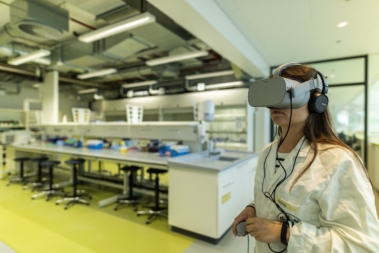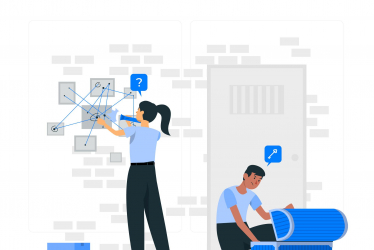Projects
Evaluating the potential of 360° VR at Leiden University
“Are you curious about what virtual reality – more specifically, 360° video – can do for your education? Then join our pilot to start your own 360 VR project!”
With this call for proposals on our website in the Autumn of 2017, the Centre for Innovation kicked off a Leiden University-wide pilot to explore the potential of 360VR for teaching and learning. Six pioneers from different disciplines across the University were selected to join the innovation challenge. The Participants came from various educational programmes including Aging & Vitality, Environmental Studies, Lab Safety training, Archaeology, Visual Anthropology and Teachers Training.
All Pilot Projects


Educational problems and the potential of 360 VR
The Centre for Innovation works to prepare Leiden University for the digital future by transferring innovations in teaching and learning. With this goal in mind, we started the pilot with a simple premise: 360 VR is a promising and affordable tool for education. Immersion in a virtual world can be valuable to someone’s learning process in many ways; students can experiencea situation that ordinarily isn’t accessible to them because in VR they can be provoked with an emotional response. These responses include empathising with others or training in a safe environment where they can fail and start over.
Our expectations were that 360 VR can prepare students for real-life situations, unlike other media. We also believed that the understanding of theoretical concepts can be enhanced with realistic 360 VR experiences. And lastly, we expected that the immersive experience will enhance the motivation of students.
Every project in the pilot had a concrete educational challenge:
- How do we teach science students about safety and risks if they haven’t worked in a science lab before?
- Can we give archaeology students fieldwork experience before they go on their first excavation?
- How do we prepare medical students for the aggressive and problematic behaviour of elderly patients with dementia?
- Can 360 video be a valuable research tool for ethnographic fieldwork?
- In what way can we teach noticing skills and effective responses to high school teachers?
- How can we explain complex, abstract remote sensing technologies and their use for understanding environmental problems?
We envisioned that all of these learning challenges could be overcome by employing 360 VR.
Groundbreaking features of 360 VR for our pilot
Our pilot was based on 360 video rather than digital VR. This offered several advantages:
- Instead of creating a simulated, stripped-down environment, we could bring students to a real location (a lab, an excavation, etc.);
- Many of the apps involved complex actions and elaborate storylines. Working with 360 video, we could employ the creative talents of real actors, which enhanced the realism of the experiences;
- The CFI has extensive in-house experience with film and storytelling, which we could translate to this new medium;
- The entire production pipeline is much more affordable for 360 video, as opposed to digital VR, from content creation to classroom delivery.
By using a special 360 camera, it is possible to record your surroundings in a 360° radius. The video can be viewed in all directions when played on an appropriate platform (e.g. YouTube), but this experience does not offer the option of immersion in the situation. You’re still looking at another world through a screen, and manipulating your viewpoint with a mouse is unnatural. To take the experience one step further, the viewer can put on VR goggles such as the Oculus Go, and simply turn his or her head to view the video in all directions. Our 360 videos are stereoscopic, which means the image has depth to it, just as real-life. This gave us more options to manipulate space. Additionally, you can add spatial audio, or ‘360 audio’ to the experience. This means that audio sources are placed within a space, like in the real world. Due the inherent multimodal perception of images and audio, spatial audio adds to the immersivity of a 360 video, as the human brain also uses sound to perceive its position in a 3D space. These groundbreaking features of 360 video offer the user a new kind of experience that stimulates immersion and a feeling of presence. The CFI believes that these effects will have a positive effect on learning processes.
By implementing interactivity, we turned 360 videos into true virtual reality. Nearly all of our VR experiences are applications, not just videos. They contain questions, choices, metrics, and gaming elements. This turns a passive experience into an active one. The user is required to participate in order to progress through an app.
Fast changing technology as benefit
When working with emergent technologies, you will notice that technological developments happen quickly. This can be a downside when developing applications, because the tools you use for filming, editing and viewing 360 VR are rapidly outdated. However it can also be an advantage. Since the start of our pilot, important releases made the accessibility and possible impact of our work much bigger. Three developments are worth mentioning.
- Release of the Insta360 Pro (camera): We started with a rig that contained six GoPro cameras. They all operated independently, with different color temperatures and slightly different exposure times. Afterwards came the laborious job to sync them all up, match the colors, and stitch them together. The Insta360 Pro was a huge step into professionalising our workflow. This camera films in 8k, is able to film stereoscopic footage, and has everything in one package. The Insta360 Pro streamlined the filming and editing process, with higher-quality videos as a result.
- Release of VR goggles Oculus Go: in 2018, affordable, un-tethered VR goggles came onto the market: the Oculus Go. This consumer-ready device was a great solution for our pilot: it offered high-quality and affordable VR in one convenient package. Before, we struggled with mobile phones, which we had to slide into a plastic headset. This created logistical challenges, and undermined the user-friendliness and thus the learning experience. The Go enabled us to easily show our apps, and it made wide-spread implementation feasible.
- Availability of editing tools: When we started our experimentation, there was no way of previewing your edits. 360 video and spatial audio were just gaining traction. There were no editing suites with built-in support for either. Instead, we had to rely on rickety, third-party plugins. As time went on, Adobe, Unity, Google and Facebook/Oculus released updates and new software, allowing us to preview our results in VR. This greatly enhanced our workflow, both time- and quality-wise.
Development process: co creation as challenging backbone of innovation
We believe that you get the highest quality outcomes, when you create applications in a multidisciplinary team. Therefore we worked closely in collaboration with students and teachers. The teacher is very important as subject matter expert, and the students provide the user perspective. As a Centre we added more disciplines to each project team: a filmmaker to create and direct 360 films, a Unity developer to design and build the VR application, an instructional designer for the learning design, and lastly a project manager who kept track of the innovation project.
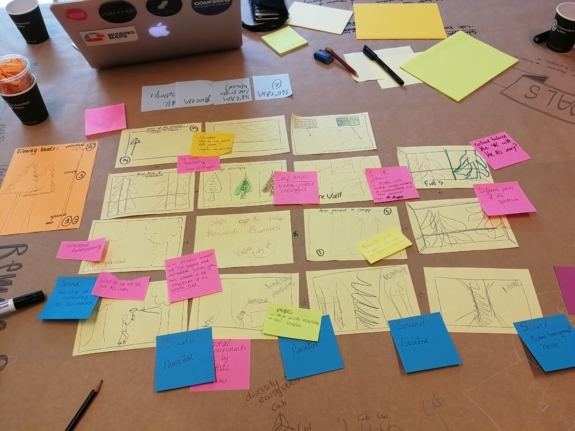
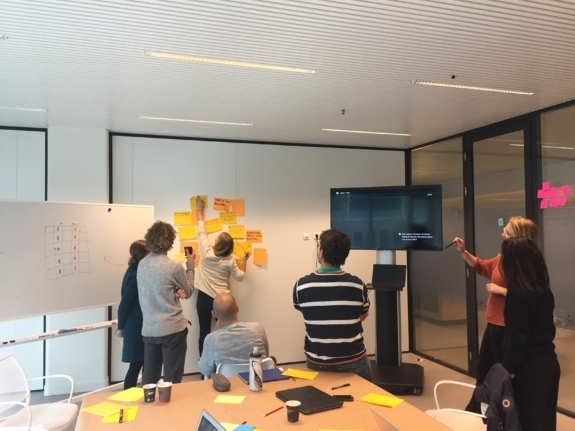
We believe that you get the highest quality outcomes, when you create applications in a multidisciplinary team. Therefore we worked closely in collaboration with students and teachers. The teacher is very important as subject matter expert, and the students provide the user perspective. As a Centre we added more disciplines to each project team: a filmmaker to create and direct 360 films, a Unity developer to design and build the VR application, an instructional designer for the learning design, and lastly a project manager who kept track of the innovation project.
During the pilot, we had to overcome challenges to find an optimal workflow with each other. Each discipline has it own norms and working methods that had to be combined. We spoke different languages and had to find a common way of communication, not only with teachers but also within the innovation team. For creating 360VR apps, we found a solution in breaking down the workload in a few, clearly defined sprints that helped to make a project feasible. We also learned from experience that managing this kind of innovation project can best be done with choosing the best working method for each stage. Designing apps can profit for example from design thinking methodology, app development can benefit from Scrum methods, and managing the whole pilot can profit from standard project management tools.
Innovation Results
The University wide innovation pilot has given us valuable input on how teachers want to use VR, in what context they use it and why they think VR is valuable for academic teaching. For the organisation, we have gained new (hands-on) knowledge about producing 360 video, building VR applications and managing this type of innovation pilots. We created templates and tools for teachers that are interested in applying 360 Video in their education or research, which is a process that can now be handed over to faculties.
The experience of teachers and students was overwhelmingly positive. The teachers who worked with us see the potential of VR for their teaching domain, and recommend colleagues and University leaders to invest further in this learning tool. As a Centre it is our ambition to guide the organisation with the next steps of implementing, scaling and researching the effects of VR apps to 2000+ students during the coming academic years.
Highlights of our Pilot results
Delivery of six VR applications to use in class, with a potential reach of 2000+ students each year
Insights in what learning context 360VR is used by teachers. We see a real possibility in the use of 360VR to bridge the gap between theory and practice (e.g. Remote Sensing, Lab safety, ethnographic fieldwork), making learning situations accessible by being virtually present (e.g. Archaeological excavations, the classroom experience) and provoking emotional responses (e.g. Gedrag Geen Probleem/dementia experience);
Valuable knowledge about producing 360 films, such as: optimal position & height of the camera when filming in 360 radius; how to tell stories in 360 radius, with effects on roleplaying and agency; directing a film where there is no ‘behind the camera’ position; using and implementing 3D sound (360 audio); using and implementing 3D sound (360 audio).
A pipeline and workflow for 360 video, that can be handed over to the faculties to offer to more teachers this teaching tool;
A framework for 360 VR applications in Unity
Discovery by professors of a new frontier (immersive ethnography) in teaching & practicing ethnographic fieldwork.


